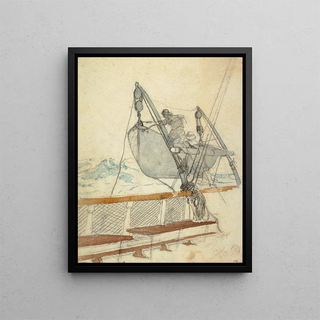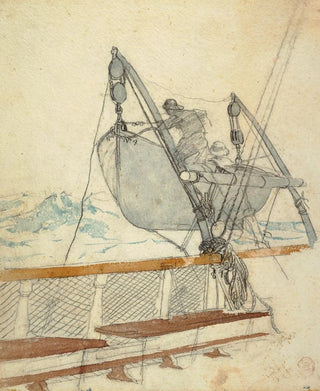Art print | Study for The Signal of Distress - Winslow Homer


View from behind

Frame (optional)
Art print Study for The Signal of Distress - Winslow Homer – Captivating Introduction
The artwork "Study for The Signal of Distress" by Winslow Homer is part of a pivotal moment in American art history. Created in the heart of the 19th century, this study foreshadows an iconic painting that explores universal themes such as danger, bravery, and man's struggle against nature. In this piece, Homer manages to capture the very essence of human emotion while evoking the power of the elements. This painting, both poignant and dramatic, invites the viewer to immerse themselves in an atmosphere where the sea is both accomplice and adversary. The art print of this work allows for a rediscovery of the artist's genius and an appreciation of the depth of his message.
Style and uniqueness of the work
The work stands out for its bold treatment of light and shadow, which gives a palpable intensity to the scene depicted. The tumultuous waves, rendered with remarkable precision, seem almost to come alive under the artist's brush. The color palette, both rich and nuanced, evokes the wild beauty of the ocean while emphasizing the urgency of the situation. The human figures, though small compared to the vastness of the sea, are charged with an emotional strength that transcends their size. Homer thus succeeds in creating a balance between the landscape and the characters, making the composition both dynamic and harmonious. This study is not limited to a simple representation of nature; it becomes a true visual narrative, inviting the viewer to question the human condition and its relationship with the environment.
The artist and his influence
Winslow Homer is often regarded as one of the pioneers of modern American painting. His work, marked by a deep sensitivity to nature and human struggles, has influenced many artists who followed. Born in 1836, Homer initially worked as an illustrator before fully dedicating himself to painting. His on-the-ground experience, notably during the Civil War, enriched his artistic vision, allowing him to capture moments of tension and drama with rare authenticity. The impact of his work is felt well beyond his

Matte finish

View from behind

Frame (optional)
Art print Study for The Signal of Distress - Winslow Homer – Captivating Introduction
The artwork "Study for The Signal of Distress" by Winslow Homer is part of a pivotal moment in American art history. Created in the heart of the 19th century, this study foreshadows an iconic painting that explores universal themes such as danger, bravery, and man's struggle against nature. In this piece, Homer manages to capture the very essence of human emotion while evoking the power of the elements. This painting, both poignant and dramatic, invites the viewer to immerse themselves in an atmosphere where the sea is both accomplice and adversary. The art print of this work allows for a rediscovery of the artist's genius and an appreciation of the depth of his message.
Style and uniqueness of the work
The work stands out for its bold treatment of light and shadow, which gives a palpable intensity to the scene depicted. The tumultuous waves, rendered with remarkable precision, seem almost to come alive under the artist's brush. The color palette, both rich and nuanced, evokes the wild beauty of the ocean while emphasizing the urgency of the situation. The human figures, though small compared to the vastness of the sea, are charged with an emotional strength that transcends their size. Homer thus succeeds in creating a balance between the landscape and the characters, making the composition both dynamic and harmonious. This study is not limited to a simple representation of nature; it becomes a true visual narrative, inviting the viewer to question the human condition and its relationship with the environment.
The artist and his influence
Winslow Homer is often regarded as one of the pioneers of modern American painting. His work, marked by a deep sensitivity to nature and human struggles, has influenced many artists who followed. Born in 1836, Homer initially worked as an illustrator before fully dedicating himself to painting. His on-the-ground experience, notably during the Civil War, enriched his artistic vision, allowing him to capture moments of tension and drama with rare authenticity. The impact of his work is felt well beyond his






